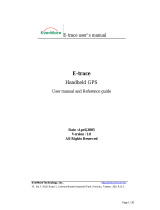
Viewing a Waypoint .........................................................................27
Accessing the Waypoint Function Menu..........................................28
Projecting a Waypoint......................................................................28
Editing a Waypoint...........................................................................29
Deleting a Waypoint.........................................................................30
Routes...................................................................................... 31
Activating a GOTO Route................................................................31
Accessing the Route Menu..............................................................32
Creating a Multileg Route ................................................................32
Activating and Deactivating a Route................................................34
Reversing a Route...........................................................................34
Viewing the Route Summary (Edit Option).....................................35
Viewing the Legs of a Route............................................................35
Inserting a Leg in a Route ...............................................................35
Deleting a Leg .................................................................................36
Adding a Leg ...................................................................................37
Replacing a Waypoint......................................................................38
Navigating (Activating) a Leg...........................................................38
Deleting a Route..............................................................................39
Creating a MOB (Man OverBoard) Route .......................................39
Creating a Backtrack Route.............................................................40
Creating a COORD Route ...............................................................40
Viewing the LAST FIX Trip Summary Screen..................................41
Last Fix Buffer .......................................................................... 41
Viewing a LAST FIX.........................................................................41
SETUP Options........................................................................ 42
Initializing the Receiver....................................................................42
Setting the Coordinate System........................................................43
Setting the Elevation Mode..............................................................43
Selecting Time Display ....................................................................44
Setting Velocity Averaging ...............................................................44
Setting Speed Units.........................................................................44
Setting Distance Units .....................................................................45
Setting Elevation Units ....................................................................45
Setting North Reference. .................................................................45
Selecting Map Datum ......................................................................45
Setting NMEA ..................................................................................45
Selecting Baud Rate........................................................................46
Selecting Waypoint Sort ..................................................................46
Selecting the Last Fix Interval .........................................................46
Plot Setup ........................................................................................46
Sampling..........................................................................................47





















